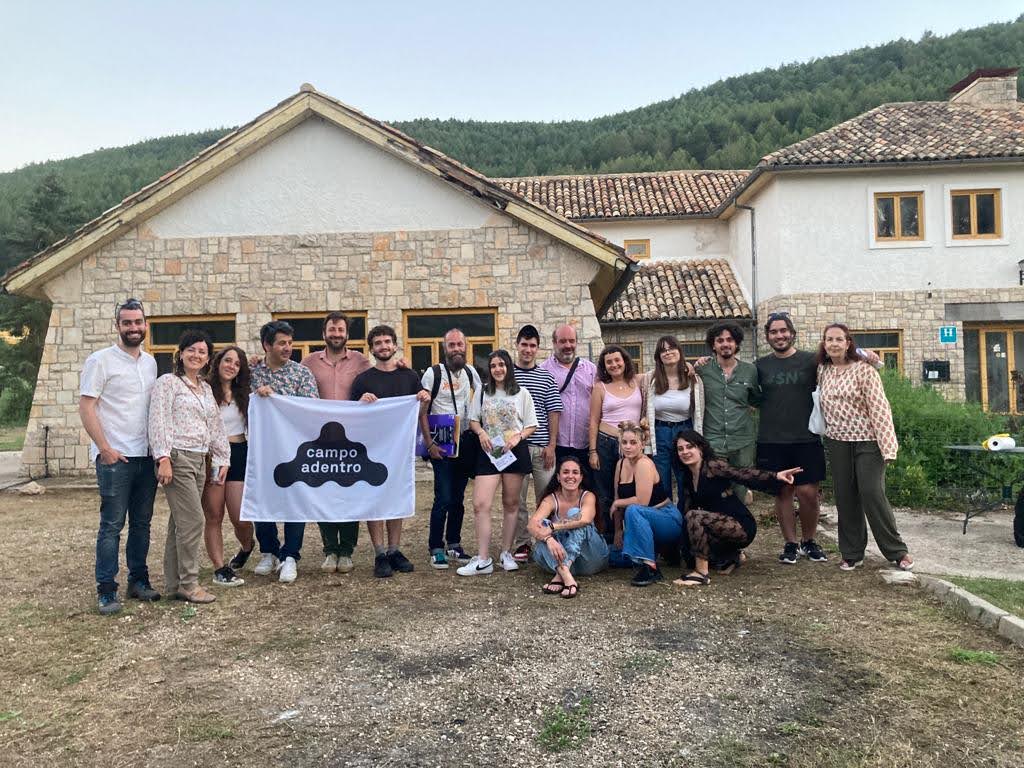The Mobile Method tour and exchange period in the Serranía de Cuenca has come to an end, marking a successful collaboration between students from the University of Castilla-la Mancha and local cultural agents. Over the course of ten days, students from various disciplines such as Fine Arts, Audiovisual Communication, Journalism, and Education have engaged in collaborative processes centered around the Cañada Real Conquense transhumance.
The project, organized by Campo Adentro in partnership with the Ministry of Culture and Sports and the Los Maestros Foundation, aimed to bridge the gap between contemporary art and transhumance. The multidisciplinary team, which included nomadic shepherds, local residents, and guest mentors, worked together in Tragacete and other nearby neighborhoods to explore the cultural legacy and reality of transhumance in the region.
The project was shared with the residents of the region during the San Juan festivities in Tragacete and will be presented during the upcoming Forum of Culture and Rural Environment organized by the Ministry of Culture. The project will also be exhibited at the Antonio Pérez de Cuenca Foundation and featured in a podcast program that will be broadcast on RNE, providing a platform to share the process and experiences of the project.
Throughout the immersive process, the team activated five tools from the Método Móvil repertoire. These tools included Radio Móvil, a nomadic recording studio for capturing the soundscape and creating ambient records and interviews. Another tool, ‘Field Microarchitectures,’ focused on studying local constructive solutions and proposing designs for infrastructures to support transhumance. The third axis of work, “Body, sustenance, and territory,” explored the link between performing arts, traditional culture, and culinary traditions in the area.
In addition to the artistic and cultural aspects of the project, a group of Education students accompanied the process, conducting workshops with children from Tragacete. Communication and Journalism students also played a role in documenting and supporting the project.
The collaboration between the University of Castilla-La Mancha, the Antonio Pérez Foundation, LIFE Cañadas, the State Federation of Pastors, and the municipalities of Tragacete and Beamud was crucial in making this project a success. The support of the Chair of Opportunities for the Demographic Challenge of the Diputación de Cuenca further contributed to the project’s achievements.
The Mobile Method project has provided a unique opportunity for students and local residents to engage with the cultural heritage of transhumance and propose future solutions for a region affected by demographic challenges. The project’s outcomes will be showcased at the upcoming VI Culture and Ruralities Forum in Cuenca, further highlighting the importance of this collaborative endeavor.
Text: Joseph An. Montero (2010) www.joseanmontero.com)
Photos: Laura Lezcano, Enrique González, and Cristina Rojas.
How did the students capture the beauty and complexity of the transhumance culture in their artistic and media projects?
Cuenca Museum in the coming months.
During their time in the Serranía de Cuenca, the students participated in a series of workshops and activities aimed at immersing them in the traditions and practices of transhumance. They learned about the history of the Cañada Real Conquense, a traditional route used by shepherds to move their livestock from the mountains to the plains, and engaged with the local community to gain a deeper understanding of its cultural significance.
Through various artistic and media projects, the students aimed to bring contemporary perspectives and interpretations to the traditional practice of transhumance. They used mediums such as photography, film, painting, and writing to capture the beauty and complexity of the transhumance culture, highlighting its relevance in the modern world.
The Mobile Method tour and exchange period provided a unique opportunity for the students to collaborate and learn from each other’s expertise. The diverse backgrounds and disciplines of the participants allowed for a truly interdisciplinary approach, resulting in a rich and multifaceted exploration of transhumance.
The collaboration between the University of Castilla-la Mancha, Campo Adentro, and local cultural agents not only fostered creativity and cultural exchange but also contributed to the preservation and promotion of the region’s cultural heritage. By engaging with the local community and sharing their work during the San Juan festivities and the Forum of Culture and Rural Environment, the students helped to raise awareness and appreciation for transhumance.
The success of the Mobile Method tour and exchange period in the Serranía de Cuenca serves as a testament to the power of collaboration and interdisciplinary approaches in the field of cultural preservation and artistic expression. It demonstrates the potential for contemporary art to bridge the gap between tradition and modernity, and showcases the importance of preserving and celebrating cultural practices that are deeply rooted in local communities.



The Mobile Method is an innovative approach that beautifully captures the essence of transhumance through art and collaboration in the stunning Serranía de Cuenca. A true testament to the power of creativity and community, this article sheds light on the profound impact of preserving traditional practices in a rapidly changing world.